Observation: During a solar eclipse you see that the stars along the same line of sight as the Sun are shifted "outward". This is because the light from the star behind the Sun is bent toward the Sun and toward the Earth. The light comes from a direction that is different from where the star really is. But wouldn't Newton's law of gravity and the result from Einstein's Special Relativity theory that E = mc2 predict light deflection too? Yes, but only half as much. General Relativity says that time is also stretched so the deflection is twice as great.
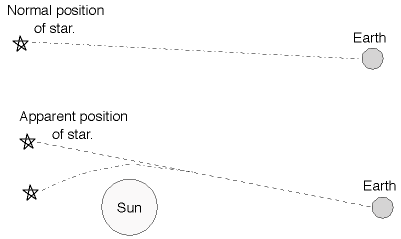
Observation: The light from quasars is observed to be bent by gravitational lenses produced by galaxies between the Earth and the quasars. It is possible to see two or more identical images of the same background quasar. In some cases the light from background quasars or galaxies can be warped to form rings. Since the amount of warping depends on the mass of the foreground galaxy, you can estimate the total mass of the foreground galaxy.
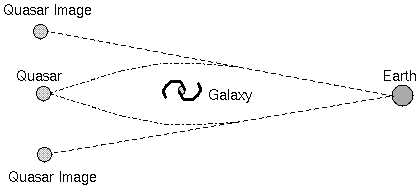
The Einstein Cross (Q2237+0305) is formed by a foreground galaxy lensing the light from a background quasar into 4 images.
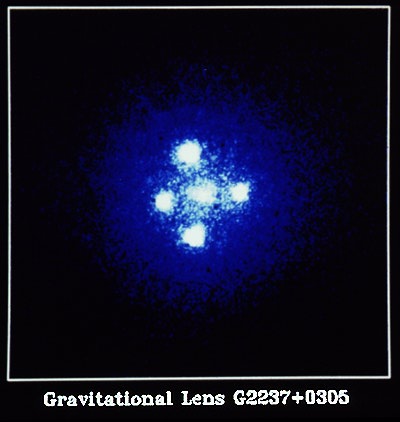
Below is a picture from the Hubble Space Telescope showing the lensing of a background galaxy by a cluster of galaxies in front. The distorted blue arcs visible around the center of the picture are the lensed background galaxy. If you select the image, an enlarged version will appear (courtesy of the Space Telescope Science Institute).
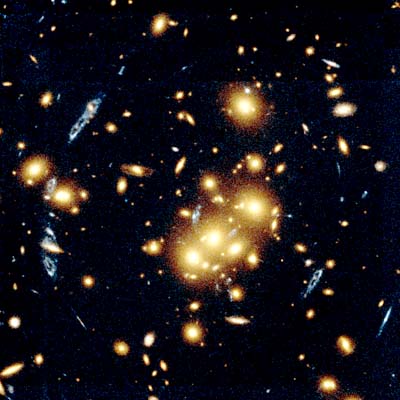
Observation: a) Clocks on planes high above the ground run faster than those on the ground. The effect is small since the Earth's mass is small, so atomic clocks must be used to detect the difference. b) The Global Positioning Satellite (GPS) system must compensate for General Relativity effects or the positions it gives for locations would be significantly off.
This is a consequence of time dilation. Suppose person A on the massive object decides to send light of a specific frequency f to person B all of the time. So every second, f wave crests leave person A. The same wave crests are received by person B in an interval of time interval of (1+z) seconds. He receives the waves at a frequency of f/(1+z). Remember that the speed of light c = (the frequency f) × (the wavelength l). If the frequency is reduced by (1+z) times, the wavelength must INcrease by (1+z) times: lat B = (1+z) × lat A. In the doppler effect, this lengthening of the wavelength is called a redshift. For gravity, the effect is called a gravitational redshift.
Observation: spectral lines from the top layer of white dwarfs are significantly shifted by an amount predicted for compact solar-mass objects. The white dwarf must be in a binary system with a main sequence companion so that the amount the total shift due to the ordinary doppler effect can be determined and subtracted out. Inside a black hole's event horizon, light is redshifted to an infinitely long wavelength.
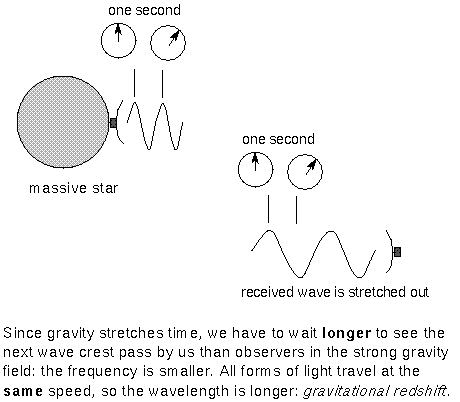
Observation: even the most sensitive detectors have not yet directly detected the tiny stretching-shrinking of spacetime caused by a massive object moving. However, the decaying orbits of a binary pulsar system discovered in 1974 by Russell Hulse and Joseph Taylor can only be explained by gravity waves carrying away energy from the pulsars as they orbit each other. This observation provides a very strong gravity field test of General Relativity.
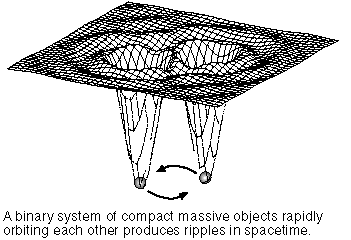
The two pulsars in the binary system called PSR1913+16 orbit each other very rapidly with a period of only 7.75 hours in very eccentric and small elliptical orbits that bring them as close as 766,000 kilometers and then move them rapidly to over 3.3 million kilometers apart. Because of their large masses (each greater than the Sun's mass) and rapidly changing small distances, the gravity ripples should be noticeable. Hulse and Taylor discovered that the orbit speed and separation of PSR1913+16 changes exactly in the way predicted by General Relativity. They were awarded the Nobel Prize in physics for this discovery.